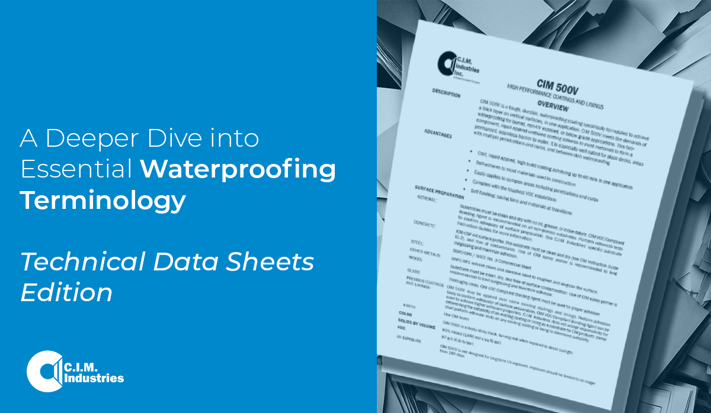
In our last installment, Waterproofing Coatings Terminology 101, we reviewed some central concepts and terms in waterproofing to define the processes and materials common to our industry. In this installment, we take a deeper dive into coating terminology with a focus on the concepts documented in important product information sheets--specifically Technical Data Sheets (TDS).
TDS' are essential for every applicator as they outline, in great detail, significant product and material attributes that are essential to firmly grasp prior to coating. Let's look at what it takes to fully read these important documents.
7 Essential Waterproofing Terms for Reading Technical Data Sheets (TDS)
One important reference document for any coating material is the Technical Data Sheet (TDS). Understanding the information on this important document typically informs coating users to help with product selection, comparing and evaluating performance properties, and general product-specific application information. Of course, to properly interpret these documents, it is essential to have a complete understanding of the common terminology these documents employ.
Let's analyze the language commonly used on TDS.
1) Technical Data Sheet (TDS)
A document describing the appropriate technical information and performance results of a product.
For waterproofing or protective coatings, a TDS provides a detailed overview of the technical characteristics, test results, and applicable certifications of the waterproofing material. Common sections of this document may include a product overview, product composition, general application information, warnings, and company contact information. This document is created by the manufacturer of the material and serves to inform specifiers & business owners as well as applicators in the waterproofing and protective coating industries.
Access our CIM Technical Library for TDS Documents
Now that we have covered the basics of the Technical Data Sheet, we will look at some terms one might commonly find in the document.
2) Solids Content
A value specific to the product that reports the number of solid substances contained within the product, typically reported in %.
Solids are what remains after any solvents or VOCs evaporate out of an applied coating. Solids Content, also referred to as Percent Solids, can be reported as a percent in relation to the total weight or total volume of the product.
Based on the density of materials used in the coating’s formula as well as the overall density of the coating, engineers would use these values when comparing different coatings, to predict thicknesses left once the material is cured and dry, and to give information about the product’s general formulation. Solids are what is remaining after any solvents or VOCs evaporate out of an applied coating.

Sample of Solids Content information from a C.I.M. TDS
3) Recoat Window/Recoating
The time range in which a chemical bond will occur between subsequent layers of coatings.
Sometimes a waterproofing application may require recoating to reach the desired thickness. The information provided here informs the applicator how much time they have to recoat one layer with the next layer of the coating without requiring any additional surface preparation. A missed recoat window can result in delamination or adhesion problems in the future. For more information, check out our guide on preparing membranes past the recoat window.
4) Adhesion
The measure of how well a material bonds to another.
Adhesion can be tested and measured between waterproofing or protective coating membrane bonds with the substrate, additional layers, other coatings, etc. Various test methods are used to determine the adhesion value. For dry concrete, for example, adhesion can be measured with an Elcometer. Without sufficient adhesion, the coating may delaminate or detach from the substrate.
5) Crack Bridging
A measure of the ability of a coating being able to bridge across a crack of set distance without being compromised.
Cracks can form in concrete or other substrates due to many factors. Waterproofing and protective coating membranes that can bridge large distances may be required in certain applications, such as concrete bridge decks and storage tanks. Sometimes the distances are cycled to see how the material performs with repeated exposure to cracks. Crack bridging is often reported in number of cycles passed without failure of the membrane over a fixed maximum distance. Ex. 100 cycles at 1/8”
6) Pot Life/Working Time
The amount of time that the coating can be successfully applied as intended.
When mixing multicomponent coatings, a chemical reaction begins to occur, and the liquid coating will become solid over time. In short, once the waterproofing membrane is prepared for use, there is only a finite window of time in which to apply the membrane.
Various application methods (squeegee, roller, spray) may have different standards for pot life and working time. For example, spray applications will have a significantly shorter working time due to the performance standards of the spray equipment, hand applications may require longer pot life to perform detailed work.
7) Chemical Resistance
The ability of a coating to resist degradation due to a specific chemical.
Different waterproofing membranes may be better suited for specific applications based on their chemical resistance. While many waterproofing and protective coating membranes are resistant to a broad range of alkalis and acids, it is important to know the chemical resistance capabilities of the specific membrane in relation to what the membrane will be in contact with. For example, a membrane suited for a potable water tank may not be suitable for application in a secondary containment or storage tank environment.
Related Article: Choosing the Right CIM Material for Your Next Job
Whether you are new to using Technical Data Sheets or a professional with intimate knowledge of the information contained within, it is critical to understand these terms and what they mean in relation to the product.
Technical Data Sheets are designed to educate you on the performance characteristics of the waterproofing membrane so that appropriate product selection is achieved. Stay tuned for subsequent blogs as we dive deeper into waterproofing terminology including materials, substrates, applications, and more.
If you are interested in learning more about any of the concepts on how they relate to your current and future jobs, reach out! We are happy to assist in answering any questions you may have.







